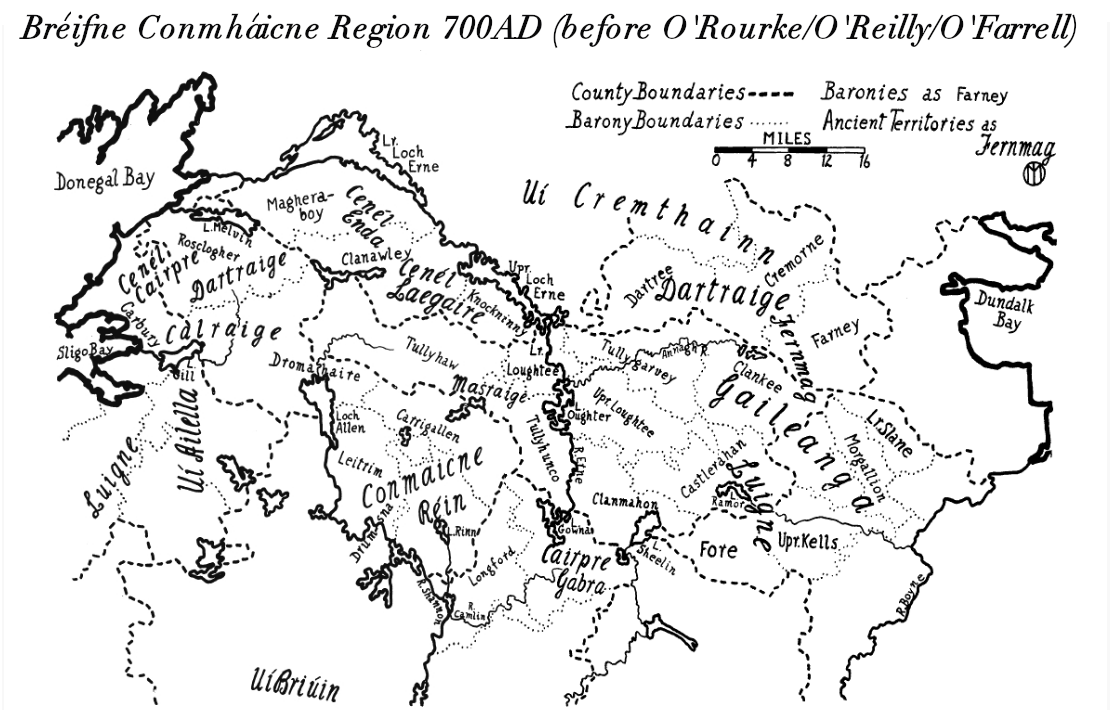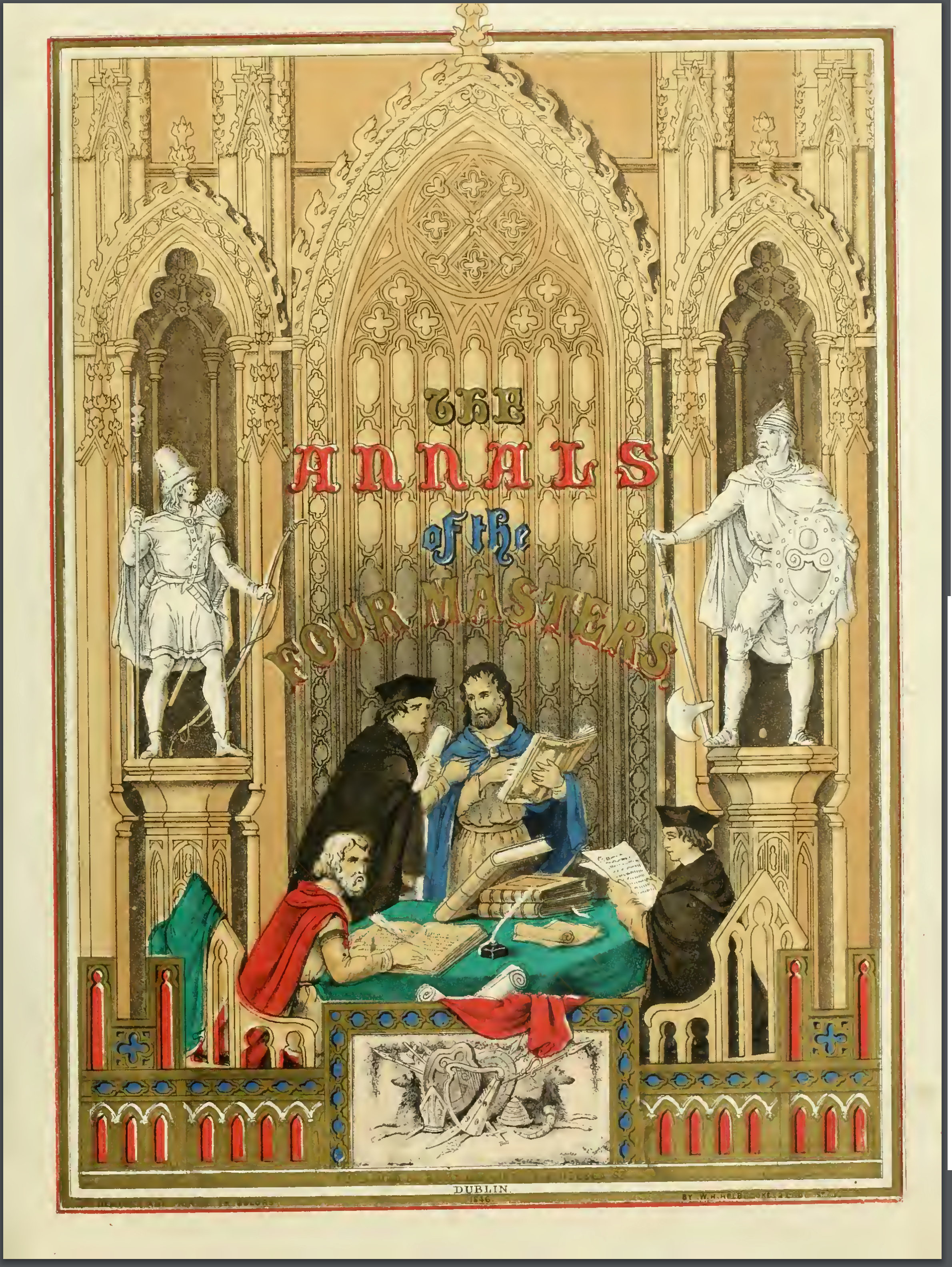|
Gíolla Íosa Mór Mág Tighearnán
Gíolla Íosa Mór Mág Tighearnán (anglicised 'Big' Gilleese McKiernan) was chief of the McKiernan Clan and Baron or Lord of Tullyhunco barony, County Cavan from c. 1269 until his death in 1279. Chieftainship Gíolla Íosa became chieftain immediately following the death of Íomhaor Mág Tighearnán, the Second. He resided in the castle of Croaghan of the Cups (Irish: Cruachan O'Cúbhrán), now in the townland of Coolnashinny, which is located beside the modern town of Killeshandra. During Gíolla Íosa's reign, he helped the O'Rourkes capture Cloughoughter Castle from the O'Reillys, although the Sheridan clan recaptured it. Death Gíolla Íosa's death was differently described in various annals: The ''Annals of Ulster'' for 1279 states ''Gilla-Issu mor Mag Tigernain, chief of Tellach Dunchadha and prop of Breifni, rested in Christ.'' The ''Annals of the Four Masters'' for 1282 states'' Gilla-Isa Mac Tiernan usually called Gilla-Isa More, Chief of Teallach-Dunchadha, die ... [...More Info...] [...Related Items...] OR: [Wikipedia] [Google] [Baidu] |
McKiernan Clan
The surname McKiernan (), is of Irish origin and is found predominantly in County Cavan where it originated. The Irish name is Mág Tighearnán meaning ''the Son of Tighearnán'' and the clan or sept takes its name from one Tighearnán who lived c. 1100 AD. He was descended from the 8th-century Dúnchadh, a descendant of Brión mac Echach Muigmedóin. Dúnchadh gave his name to Teallach Dúnchadha (Irish meaning the Hearth of Dúnchadh), the modern day barony of Tullyhunco in County Cavan. Dúnchadh’s brother was Eochaidh from whom the neighbouring McGovern clan of Tullyhaw barony descend. There are many variations found in the spelling of the name, all of which are attempts at a phonetic spelling of the Gaelic ''Mág Tighearnán''. The Mág part can be found as Mag, Meg, Mac, Mec, Mc, Ma or M'. The Tighearnán part (which may be attached to or detached from the ''Mág'' part and all its variations) can be found as Tighearnán, Thighearnán, Cighearnán, McKiernan, McKernan, Mc ... [...More Info...] [...Related Items...] OR: [Wikipedia] [Google] [Baidu] |
Annals Of Connacht
The ''Annals of Connacht'' (), covering the years 1224 to 1544, are drawn from a manuscript compiled in the 15th and 16th centuries by at least three scribes, all believed to be members of the Clan Ó Duibhgeannáin. The early sections, commencing with the death of King Cathal Crobdearg Ua Conchobair of Connacht, are exceptionally detailed and give a good account of Connacht affairs during the 13th and early to mid-14th century, particularly for the families of O'Conor and Burke. The accounts however become more desultory, especially for the 16th century. Nevertheless, it is an invaluable document relating much that would have otherwise remained utterly obscure or unknown in the history of Connacht, and Ireland in general. A comparison between it and the '' Annals of Clonmacnoise'' reveal a common source, or perhaps one is a partial copy of the other. See also * Irish annals References * External links The Annals of Connacht [...More Info...] [...Related Items...] OR: [Wikipedia] [Google] [Baidu] |
1279 Deaths
1 (one, unit, unity) is a number, numeral, and glyph. It is the first and smallest positive integer of the infinite sequence of natural numbers. This fundamental property has led to its unique uses in other fields, ranging from science to sports, where it commonly denotes the first, leading, or top thing in a group. 1 is the unit of counting or measurement, a determiner for singular nouns, and a gender-neutral pronoun. Historically, the representation of 1 evolved from ancient Sumerian and Babylonian symbols to the modern Arabic numeral. In mathematics, 1 is the multiplicative identity, meaning that any number multiplied by 1 equals the same number. 1 is by convention not considered a prime number. In digital technology, 1 represents the "on" state in binary code, the foundation of computing. Philosophically, 1 symbolizes the ultimate reality or source of existence in various traditions. In mathematics The number 1 is the first natural number after 0. Each natural number, ... [...More Info...] [...Related Items...] OR: [Wikipedia] [Google] [Baidu] |
Irish Lords
''Hemilepidotus'', the Irish lords, is a genus of ray-finned fishes belonging to the family Agonidae, the poachers and sea ravens. These fishes are found in northern Pacific, northern Atlantic and Arctic oceans. Species There are currently six recognized species in this genus: * '' Hemilepidotus gilberti'' D. S. Jordan & Starks, 1904 (Gilbert's Irish lord) * ''Hemilepidotus hemilepidotus'' ( Tilesius, 1811) (Red Irish lord) * '' Hemilepidotus jordani'' T. H. Bean, 1881 (Yellow Irish lord) * '' Hemilepidotus papilio'' (T. H. Bean, 1880) (Butterfly sculpin) * '' Hemilepidotus spinosus'' Ayres, 1854 (Brown Irish lord) * '' Hemilepidotus zapus'' C. H. Gilbert & Burke Burke (; ) is a Normans in Ireland, Norman-Irish surname, deriving from the ancient Anglo-Norman and Hiberno-Norman noble dynasty, the House of Burgh. In Ireland, the descendants of William de Burgh (''circa'' 1160–1206) had the surname'' de B ..., 1912 (Longfin Irish lord) References Agonidae Marine ... [...More Info...] [...Related Items...] OR: [Wikipedia] [Google] [Baidu] |
Tomás Mág Samhradháin The Second
{{disambiguation ...
Tomás may refer to: * Tomás (given name) * Tomás (surname) Tomás is a Spanish, Portuguese, or Irish surname, equivalent of '' Thomas''. It may refer to: * Antonio Tomás (born 1985), professional Spanish footballer * Belarmino Tomás (1892–1950), Asturian trade unionist and socialist politician * ... [...More Info...] [...Related Items...] OR: [Wikipedia] [Google] [Baidu] |
Tullyhaw
Tullyhaw (, which means 'the Territory of Eochaidh', an ancestor of the McGoverns, who lived ) is a Barony in County Cavan in Ireland. The area has been in constant occupation since pre-4000 BC. Located in the northwest of the county, it has been referred to as Cavan's panhandle. Tullyhaw was originally a ''túath'' within West Bréifne. It was later absorbed into East Bréifne in the sixteenth century. Glangevlin.com: History - The Kingdom Of The McGoverns. https://www.glangevlin.com/2021/05/13/the-kingdom-of-the-mcgoverns/ In 1579, East Bréifne, then part of Connacht, was made a shire. The shire was named County Cavan, being named after Cavan (), the area's main town. The administration remained in the control of the local Irish dynasty and subject to the Brehon and Canon Law. In 1584, Sir John Perrot formed the shire into a county in Ulster. It was subdivided into seven baronies: *two of which were assigned to Sir John O'Reilly and *three to other members of th ... [...More Info...] [...Related Items...] OR: [Wikipedia] [Google] [Baidu] |
Brian 'Breaghach' Mág Samhradháin
Brian (sometimes spelled Bryan in English) is a male given name of Irish and Breton origin, as well as a surname of Occitan origin. It is common in the English-speaking world. It is possible that the name is derived from an Old Celtic word meaning "high" or "noble". For example, the element ''bre'' means "hill"; which could be transferred to mean "eminence" or "exalted one". The name is quite popular in Ireland, on account of Brian Boru, a 10th-century High King of Ireland. The name was also quite popular in East Anglia during the Middle Ages. This is because the name was introduced to England by Bretons following the Norman Conquest. Bretons also settled in Ireland along with the Normans in the 12th century, and 'their' name was mingled with the 'Irish' version. Also, in the north-west of England, the 'Irish' name was introduced by Scandinavian settlers from Ireland. Within the Gaelic-speaking areas of Scotland, the name was at first only used by professional families of Irish o ... [...More Info...] [...Related Items...] OR: [Wikipedia] [Google] [Baidu] |
Annals Of Clonmacnoise
The ''Annals of Clonmacnoise'' () are an early 17th-century Early Modern English translation of a lost Irish chronicle, which covered events in Ireland from prehistory to 1408. The work is sometimes known as ''Mageoghagan's Book'', after its translator Conall the Historian. David Sellar, who was the Lord Lyon King of Arms in Scotland, concluded that it dates from 1627. Robert Anthony Welch also stated that while it records history from the earliest times up to 1408, the original manuscript has been lost and it survives in an English translation that dates from 1627. Translation The Irish chronicle was translated into English, in the style of the Elizabethan period, in 1627 by Conall Mag Eochagáin, of Lismoyny (County Westmeath), near Clara, County Offaly. Mag Eochagáin dedicated this translation to his brother-in-law, Toirdhealbhach Mac Cochláin, whose family was among the last to uphold and practice native Irish Gaelic customs. The translation was completed on 20 Apri ... [...More Info...] [...Related Items...] OR: [Wikipedia] [Google] [Baidu] |
Annals Of Loch Cé
The ''Annals of Loch Cé'' (also ''Annals of Lough Cé'') cover events, mainly in Connacht and its neighbouring regions, from 1014 to 1590. It takes its name from Lough Cé in the kingdom of Moylurg - now north County Roscommon - which was the centre of power of the Clan MacDermot. In the sixteenth century, King Brian MacDermot commissioned the Annals of Loch Ce, which remain among the most important written records of medieval Irish history.Inside a Medieval Gaelic Castle, Jarrett A.Lobell, Archaeology, p.26, March, April 2020 issue. For its earliest centuries it used, among others, the Annals of Boyle. The largest part of the Annals are attributed to members of Clan Ó Duibhgeannáin, with some emendations by the patron, Brian na Carraige MacDermot, first MacDermot of the Carrick (died 1592). The text is in Early Modern Irish, with a portion of the text in Latin. 4 December 2021 the tradition of Irish Annals writing was revived by a calligrapher, scribe and paper/ ink m ... [...More Info...] [...Related Items...] OR: [Wikipedia] [Google] [Baidu] |
Annals Of The Four Masters
The ''Annals of the Kingdom of Ireland'' () or the ''Annals of the Four Masters'' () are chronicles of Middle Ages, medieval Irish history. The entries span from the Genesis flood narrative, Deluge, dated as 2,242 Anno Mundi, years after creation to AD 1616. Publication delay Due to the criticisms by 17th-century Irish historian Tuileagna Ó Maol Chonaire, the text was not published in the lifetimes of any of the participants. Text The annals are mainly a compilation of earlier annals, although there is some original work. They were compiled between 1632 and 1636, allegedly in a cottage beside the ruins of Donegal Abbey, just outside Donegal (town), Donegal Town. At this time, however, the Franciscans had a house of refuge by the River Drowes in County Leitrim, just outside Ballyshannon, and it was here, according to others, that the ''Annals'' were compiled. [...More Info...] [...Related Items...] OR: [Wikipedia] [Google] [Baidu] |
Baron
Baron is a rank of nobility or title of honour, often Hereditary title, hereditary, in various European countries, either current or historical. The female equivalent is baroness. Typically, the title denotes an aristocrat who ranks higher than a lord or knight, but lower than a viscount or count. Often, barons hold their fief – their lands and income – directly from the monarch. Barons are less often the vassals of other nobles. In many kingdoms, they were entitled to wear a smaller form of a crown called a ''coronet''. The term originates from the Late Latin, Latin term , via Old French. The use of the title ''baron'' came to England via the Norman Conquest of 1066, then the Normans brought the title to Scotland and Southern Italy. It later spread to Scandinavian and Slavic lands. Etymology The word '':wikt:baron, baron'' comes from the Old French , from a Late Latin "man; servant, soldier, mercenary" (so used in Salic law; Alemannic law has in the same sense). The sc ... [...More Info...] [...Related Items...] OR: [Wikipedia] [Google] [Baidu] |


